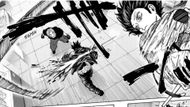Among the wide cast of assassins, spies, and eccentric killers that populate Sakamoto Days, Amane stands out as one of the most intriguing. Unlike characters in this series who are defined purely by brute strength or quirky gimmicks, Amane is written as a layered, conflicted prodigy caught between heritage, morality, and survival.
Amane in Sakamoto Days is the son of Yotsumura Satoru, a former Order member who abandoned his post and later became entangled in the mysterious organization X. His father’s betrayal not only stained the family name but also devastated them.
After the tragedy, Amane was raised by his maternal grandfather, Byodo, one of the most intelligent figures tied to the JCC. From him, Amane inherited an almost supernatural ability: instantaneous memory recall.

Anything he saw once, he could retain perfectly, even if he could not quite reach his grandfather’s legendary level. Growing up under Byodo’s guidance gave Amane academic brilliance and assassin training, but it also isolated him. Amane never left the JCC until much later in the story. As a result, his worldview was narrow, sometimes laughably so.
His uprightness was such that even Byodo worried it might put him at odds with the assassin world. This duality, brilliance wrapped in innocence, trauma tempered by kindness, makes him a character constantly balancing contradictions.
Fighting for survival: Bangkok and beyond

Amane eventually joins Sakamoto’s side, helping him infiltrate Bangkok in pursuit of Slur. His role in the battle against Kashima reveals his technical skill: he cuts apart explosives with precision, showcasing not just talent but a calmness under pressure rare for his age.
Later, during the “Killer of the Century” arc, Amane participates in brutal battles against X executives like Carolina Reaper and Kumanomi. Though only fifteen years old, he demonstrates extraordinary tactical brilliance.
He uses his sharp memory and knowledge of combat theories to manipulate the battlefield, raising room temperatures to disable Kumanomi’s electromagnet, for instance.
Abilities and weapons

Amane’s power is a fascinating blend of inherited talent and relentless training:
1) Instantaneous Memory: He can recall everything he has ever seen, a gift from his grandfather. This allows him to memorize maps, codes, and even entire languages on the fly.
2) Weapon Mastery: The weapon he chooses is known as a Sanjo-gon (three-section staff), modified with blades to extend its range and lethality. In Sakamoto Days, it’s one of the longest weapons. This means that it makes it versatile in both close and long-range combat.
3) Balanced Skillset: According to the official fanbook, his total stat parameter is 18 out of 20, placing him near Order-class levels despite being a teenager. His scores in weapon use, physical ability, and potential are especially high.
Amane’s place in the Sakamoto Days story

Although he often fights alongside Sakamoto, the narrative positions Amane in a unique way. He isn’t treated as an official “member” of the Sakamoto store, at least not yet.
The fanbook even clarifies that he is more tied to the JCC than to Sakamoto’s inner circle. This makes sense: Amane’s arc in Sakamoto Days is less about joining a family and more about confronting his own.
Final thoughts
So, who is Amane in Sakamoto Days? He is more than just Yotsumura’s son. He is a prodigy born from tragedy, a student whose intelligence and skill set him apart, and a boy struggling to reconcile the weight of his bloodline with his ideals.
In the end, Amane is a reminder that in Sakamoto Days, identity is never static; it is forged through choices, shaped by relationships, and tested in the crucible of battle.
